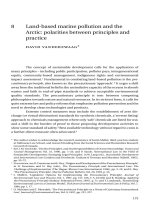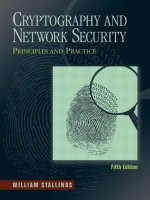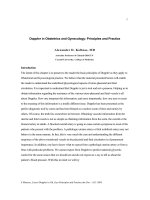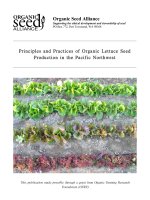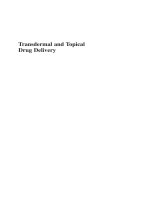compressor handbook principles and practice
Bạn đang xem bản rút gọn của tài liệu. Xem và tải ngay bản đầy đủ của tài liệu tại đây (14.06 MB, 376 trang )
Compressor Handbook:
Principles and Practice
“This page left intentionally blank.”
Compressor Handbook:
Principles and Practice
By
Tony Giampaolo, MSME, PE
Library of Congress Cataloging-in-Publication Data
Giampaolo, Tony, 1939-
Compressor handbook: principles and practice/by Tony
Giampaolo.
p. cm.
Includes index.
ISBN-10: 0-88173-615-5 (alk. paper)
ISBN-10: 0-88173-616-3 (electronic)
ISBN-13: 978-1-4398-1571-7 (Taylor & Francis : alk. paper)
1. Compressors Handbooks, manuals, etc. I. Title.
TJ990.G53 2010
621.5’1 dc22 2010008818
Compressor handbook: principles and practice by Tony Giampaolo
©2010 by The Fairmont Press. All rights reserved. No part of this publication may be re-
produced or transmitted in any form or by any means, electronic or mechanical, including
photocopy, recording, or any information storage and retrieval system, without permission
in writing from the publisher.
Published by The Fairmont Press, Inc.
700 Indian Trail
Lilburn, GA 30047
tel: 770-925-9388; fax: 770-381-9865
Distributed by Taylor & Francis Ltd.
6000 Broken Sound Parkway NW, Suite 300
Boca Raton, FL 33487, USA
E-mail:
Distributed by Taylor & Francis Ltd.
23-25 Blades Court
Deodar Road
London SW15 2NU, UK
E-mail:
Printed in the United States of America
10 9 8 7 6 5 4 3 2 1
0-88173-615-5 (The Fairmont Press, Inc.)
978-1-4398-1571-7 (Taylor & Francis Ltd.)
While every effort is made to provide dependable information, the publisher, authors,
and editors cannot be held responsible for any errors or omissions.
Pages 221-232: Compressor specications in Appendix XX From the 2009 Compressor Tech-
nology Sourcing Supplement, courtesy COMPRESSORTechTwo magazine, published by
Diesel & Gas Turbine Publications. Current compressor information can be found at www.
compressortech2 or www.CTSSNet.net.
v
Dedication
This book is dedicated to my ve grandchildren:
Amanda Rose
Anna Josephine
Carly Paige
Riley James
Nickolas Anthony
They are the future.
“This page left intentionally blank.”
vii
Contents
Preface xi
Acknowledgements xiii
Chapter 1—Introduction 1
History 1
Chapter 2—General Compressor Theory 7
Thermodynamics of Compression 7
Chapter 3—Compressor Types 15
Dynamic Compressors 15
Axial Compressors 15
Centrifugal Compressors 22
Variations in Compressor Design 25
Positive Displacement Compressors 26
Blowers 26
Reciprocating Compressors 29
Preliminary Selection and Sizing 53
Screw Compressors 58
Screw Compressor Control 59
Chapter 4—Effect of Operating Conditions 63
Effects of Temperature & Pressure 63
Effects of Compression Ratio 64
Effects of Specic Heat Ratio 65
Chapter 5—Throughput Control 73
Speed Control 73
Suction Throttling Control 73
Discharge Valve Throttling Control 74
Recycle Valve Control 74
Variable Volume Pocket Control 76
Chapter 6—Description of Surge 81
Surge & Stall 81
viii
Chapter 7—Surge Control 85
Minimum Flow Control 85
Maximum Pressure Control 85
Ratio Control 87
Chapter 8—Vibration 97
Rotor Response 97
Sources of Vibration
Chapter 9—Valve Requirements 105
Valve Types
Valve Trim
Chapter 10—Instrument Requirements 111
Sensor Types
Speed of Response
Chapter 11—Detectable Problems 115
Mechanical Problems
Electrical Problems
Performance Problems
Chapter 12—Controlling Reciprocatng and Centrifugal
Compressors in Identical Processes 131
Chapter 13—Optimization & Revitalization of Existing
Reciprocating Compression Assets 145
Chapter 14—Piston Rod Run-out is a Key Criterion for
Recip Compressors 183
Chapter 15—Effect of Pulsation Bottle
Design on the Performance of a Modern
Low-speed Gas Transmission Compressor Piston 193
Chapter 16—Resolution of a Compressor Valve Failure:
A Case Study 211
ix
APPENDIX
A1 Compressor Manufacturers 221
A2 Comparison of Three Types of Compressors 233
B1 List of Symbols 234
B2 Glossary of Terms 237
B3 Conversion Factors 267
C Gas Processers Suppliers Association
Select Curves & Charts 272
D Classication of Hazardous Atmospheres 310
E Air/Oil Cooler Specications Check List 311
F Cylinder Displacement Curves 314
G Compressor Cylinder Lubrication 319
H Troubleshooting Chart 322
I Typical Starting, Operating and Maintenance
Procedures for a Reciprocating Compressor 324
J Basic Motor Formulas and Calculations 340
INDEX 353
“This page left intentionally blank.”
xi
Preface
Compressors have played a major role in setting our standard of
living and they have contributed signicantly to the industrial revolu-
tion. Early compressors like the bellows (used to stoke a re or the water
organ use to make music) marked the beginning of a series of compres-
sion tools. Without compression techniques we could not have efciently
stabilized crude oil (by removing its trapped gasses) or separated the
various components of gas mixtures or transported large quantities of
gas cross country via gas pipelines. Today, compressors are so much a
part of our every day existence that many of us do not even recognize
them for what they are. Compressors exist in almost every business and
household as vacuum cleaners and heating & air conditioning blowers.
Even those who have worked with compressors (usually only one or
two types of compressor) have only a vague awareness of the variety
of compressors in existence today.
It is always interesting to see how the inventive process takes
place, and how the development process progresses from inception to
nal design. Therefore, included in some sections of the book is histori-
cal information on the development of various compressors. Due to the
number of different types of compressors it was too time consuming
to research the origins of each compressor type. For the roots blower
and screw compressor the inventive process is clear as discussed in
Chapters 1 and 3. However, the origin of the reciprocating compressor
is somewhat obscured. No doubt the water organ devised by Ctesibius
of Alexandria paved the way. Nevertheless, using water to compress air
in a water organ is a far cry from a piston moving within a cylinder
to compress gas. True there is signicant similarity between reciprocat-
ing engines and reciprocating compressors: Just as there is similarity
between turbo compressors and turbine expanders.
Many engineers/technicians/operators spend their entire careers in
one product discipline (manufacturing, maintenance, test, sales, etc…).
Sometimes they have had the opportunity to work in several disciplines.
This book is intended to assist in the transition from an academic back-
ground to a practical eld, or from one eld to another. It will assist the
reader in his day-to-day duties as well as knowing where to look for ad-
ditional information. Also people respond better when they understand
xii
why they are asked to perform certain functions, or to perform them in
a certain order.
My intention is to provide a basic understanding of the variety of
compressors. The need for this book has grown out of the request for
seminars and training sessions from utilities and oil & gas companies.
Most often these companies hire new employees or relocate and retrain
their current employees. The reader may have some experience in the
operation or maintenance of some compression equipment from previ-
ous assignments.
This book provides a practical introduction to dynamic and posi-
tive displacement compressors, including compressor performance, op-
eration and problem awareness. In reading this book the reader will
learn what is needed to select, operate and troubleshoot compressors
and to communicate with peers, sales personnel and manufacturers in
the eld of dynamic and positive displacement compressor applications.
In addition to the theoretical information, real life case histories
are presented. The book demonstrates investigative techniques to iden-
tify and isolate various contributing causes such as: design deciencies,
manufacturing defects, adverse environmental conditions, operating er-
rors, and intentional or unintentional changes of the machinery process
that precede the failure. Acquiring and perfecting these skills will enable
readers to go back to their workplace and perform their job functions
more effectively.
In addition to the content of this book the engineer/technician/
operator will nd that the information provided in the appendix will
become a useful reference for years to come.
Tony Giampaolo
Wellington, FL
January 2010
xiii
Acknowledgements
I would like to recognize and thank the following individuals for
their support and assistance in obtaining photographs for use in this
book:
Norm Shade, President, ACI Services, Inc.
Danny L. Garcia, Project Manager, Sun Engineering Services, Inc.
Roger Vaglia, Product Manager (Retired), Cooper Ind., White Superior
Division
John Lunn Engineering Manager (Retired) Rolls Royce USA
Everette Johnson, Engineering Manager, Cameron Compressor Corpora-
tion
Ben Suurenbroek (Retired), Cooper Energy Services—Europe
Dave Kasper, District Manager, Dresser Roots, Inc.
I also want to acknowledge and thank Peter Woinich, Design
Engineer, Construction Supervisor and Associate (Retired) of William
Ginsberger, Associates for his help in proofreading this manuscript.
Also I wish to acknowledge and thank the following companies
for their condence and support by providing many of the photographs
and charts that are in this book.
ACI Services, Inc.
Baldor Electric Company
Cameron Compressor Corporation
COMPRESSORTech
Two
magazine, published by Diesel & Gas Turbine
Publications
Dresser Roots, Inc
Gas Processors Suppliers Association
MAN Turbo AG
Oil & Gas Journal
Penn Engineering
Petroleum Learning Programs
Rolls Royce USA
Sun Engineering Services, Inc.
United Technologies Corp, Pratt & Whitney Canada
“This page left intentionally blank.”
Chapter 1
Introduction
HISTORY
The history of compressors is as varied as are the different types
ofcompressors.Thereforeitisttingthatwerstidentifythedifferent
typesofcompressors.AsshowninChart1-1,compressorsfallintotwo
separateanddistinctcategories:dynamic andpositivedisplacement.
Chart 1-1
Somewhere in antiquity the bellows was developed to increase
owintoafurnaceinordertostokeorincreasefurnaceheat.Thiswas
necessary to smeltores of copper, tin, lead and iron. This led the way
tonumerous other inventionsoftoolsandweapons.
One of the earliest recorded uses of compressed gas (air) dates
backto3
rd
centuryB.C.Thisearlyuseofcompressedairwasthe“water
organ.” The invention of the “water organ” is commonly credited to
CtesibiusofAlexandria
1
.TheconceptwasfurtherimprovedbyHeroof
Alexandria(alsonotedfordescribingtheprinciplesofexpandingsteam
toconvertsteampowerto shaftpower).
1
2 CompressorHandbook:PrinciplesandPractice
The water organ consisted of a water pump, a chamber partly
lledwithairandwater,arowofpipesontop(organpipes)ofvarious
diametersandlengthsplus connecting tubingandvalves.By pumping
water into the water/air chamber the air becomes compressed. Than
byopeningvalvestospecic organpipesthedesiredmusicalsoundis
created.
Ctesibius also developed the positive displacement cylinder and
pistontomovewater.
Itwasnotuntilthelate19
th
century
that many of these ideas were turned
intoworkinghardware.
In the 1850s, while trying to nd
a replacement for the water wheel at
theirfamily’swoolenmill,Philanderand
FrancisRootsdevisedwhathascometo
be known as the Roots blower
3
. Their
designconsistedofapairofgure-eight
impellersrotatinginoppositedirections.
While some Europeans were simultane-
ously experimenting with this design,
the Roots brothers perfected the design
andputitintolarge-scaleproduction.
It is not surprising that other
compressor designs followed power-
Figure 1-1. Water Organ De-
veloped By Ctesibius.
2
Figure 1-2. Photo Courtesy of Frick by Johnson Controls.
Introduction 3
producingdesigns.Forexample,thereciprocatingengineconcepteasily
transferstothereciprocatingcompressor.
The integral-engine-compressor is a good example as its design
utilizes one main shaft connected to both the power cylinders and
the compression cylinders. The form and function of the compressor
cylinders are the same whether it is congured as an integral engine-
compressoror a separable-compressor driven by an electric motor,gas
engineorturbine.
Other examples are the centrifugal compressor, (Figure 1-4) the
turbo-expander, the axial compressor, and the axial turbine (Figure 1-5
and1-6).
In 1808 John Dumball envisioned a multi-stage axial compressor.
Unfortunatelyhisideaconsistedonlyofmovingbladeswithoutstation-
aryairfoilstoturnthe owintoeachsucceedingstage.
4,5,6
Notuntil1872didDr.FranzStolzecombinetheideasofJohnBar-
Figure 1-3. Cooper-Bessemer Z-330 Integral Engine Compressors in Krun-
mhorn, Germany. Courtesy of Ben Suurenbroek (Retired Cooper Energy
Services)
4 CompressorHandbook:PrinciplesandPractice
ber and John Dumball to develop the rst axial compressor driven by
an axial turbine. Due to a lack of funds, he didnot build his machine
until1900.Dr.Stolze’sdesignconsistedofamulti-stageaxialowcom-
pressor,asinglecombustionchamber,amulti-stageaxialturbine,anda
regeneratorutilizingexhaustgasestoheatthecompressordischargegas.
Thisunitwastestedbetween1900and1904,butneverransuccessfully.
Operating conditions have a significant impact on compressor
Figure 1-4. Barrel
Compressor Cour-
tesy of Rolls-Royce
USA (formerly Coo-
per Industries En-
ergy Services).
Figure 1-5. Five
Stage Power Tur-
bine Rotor From
RT15 Turbine De-
signed For 12,000
RPM Courtesy of
Rolls-Royce USA
(formerly Cooper
Industries Ener-
gy Services).
Introduction 5
Figure 1-6. Courtesy of
United Technologies
Corporation, Pratt &
Whitney, Canada. The
ST-18 is a 2 Megawatt
Aeroderivative Combin-
ing Centrifugal Com-
pressor & Axial Expan-
sion Turbine.
selectionandcompressorperformance.Theinuencesofpressure,tem-
perature,molecularweight,specicheatratio,compressionratio,speed,
vaneposition,volumebottles,loadersandunloaders,etc.areaddressed
inthisbook.Theseconditionsimpactcompressorcapacityandtherefore
the compressor selection. They also impact the compressor efciency.
Flexibilityinselectionisstillpossibletosomeextentascompressorscan
beoperatedinparallelandseriesmodes.Forexample,toachievehigher
pressuresmultiplecompressorscanbeconguredinserieswherebythe
dischargeof onecompressorfeedsdirectlyintothesuctionofa second
compressor,etc.Likewise,toachievehigherowsmultiplecompressors
can be congured in parallel whereby the suction of each compressor
is manifolded together and the discharge of each compressor is also
manifoldedtogether.
DifferentmethodsofthroughputcontrolareaddressedinChapter
5,suchas,dischargethrottling, suctionthrottling,guidevaneposition-
ing,volumebottles,suctionvalveunloadersandspeedcontrol;andhow
eachofthesecontrolmethodseffects compressorlife.
This book discusses different compressors; how they operate and
howtheyarecontrolled. Since the cost of processdowntimeanddam-
age to a compressor can range from thousands to millions of dollars;
the types of failures that can occur and how to avoid these failures is
alsoaddressed in thisbook.
In view of the fact that the most destructive event in a dynamic
compressorissurge,compressorsurgewillbedenedanddiscussedin
detail.Alsodiscussedarethevarioustypesofinstrumentation(control-
lers, valves, pressure and temperature transmitters, etc ) available and
6 CompressorHandbook:PrinciplesandPractice
whicharemostsuitableincontrollingsurge.Destructivemodesofother
compressorsarealsoaddressed.
A few algorithms are presented, primarily in Chapters 4 and 7,
tohelpdemonstrateinteractionsofpressure, temperatureandquantify
results, but their understanding is not essential to the selection of the
proper control scheme and instrumentation. The reader should not be
intimidated by these algorithms as their understanding will open up a
broaderappreciationofhowthecompressorworks.
Footnotes
1 A History of Mechanical Inventions,AbbottPaytonUsher.ThisDover
edition,rstpublishedin1988,isanunabridgedandunalteredre-
publicationoftherevisededition(1954)oftheworkrstpublished
byHarvard University Press,Cambridge,MA, in1929.
2 Multiple sources werefound for this sketch, none of which refer-
encedasource.
3 Initiative In Energy, The Story of Dresser Industries, Darwin Payne,
1979
4 Engines—The Search for Power, John Day,1980
5 The Gas Turbine, Norman Davy,1914
6 Modern Gas Turbines,Arthur W.Judge1950
Chapter 2
General Compressor Theory
Compressors are mechanical devices used to increase the pres-
sureofair,gasorvaporandintheprocessmoveitfromonelocation
to another. The inlet or suction pressure can range from low sub-
atmospheric pressure levels to any pressure level compatible with
piping and vessel strength limits. The ratio of absolute discharge
pressuretoabsolutesuctionpressureisthecompressorpressureratio
(CR—seeAppendixB2,GlossaryofTerms).Stagecompressionislim-
ited to the mechanical capabilities of the compressor and, generally,
approachesaCRof4.Toachievehighpressuresmultiplestagesmust
be employed.
CompressiontheoryisprimarilydenedbytheIdealGasLaws
andtheFirst&SecondLawsofThermodynamics.Asoriginallycon-
ceivedtheIdealGasLawisbasedonthebehaviorofpuresubstances
and takes the following form:
Pv =RT (2-1)
Where
P =Absolute Pressure
v = Specic Volume
R = Gas Constant
T =Absolute Temperature
ThisequationisbasedonthelawsofCharles,Boyle,Gay-Lussac
andAvogadro (see Appendix B2 Glossary of Terms).
Note all properties should be dened in the same measuring
system(forexample either theEnglishsystemor themetricsystem).
Conversion factors listed in Appendix B3 can be used to assist in
obtaining consistent units. Table 2-1 sums up the two systems.
7
8 CompressorHandbook:PrinciplesandPractice
Table 2-1.
———————————————————————————————————
Parameter Symbol EnglishSystem MetricSystem
———————————————————————————————————
Pressure P Absolute Pascalsor
pressure(psia) Kilopascals
———————————————————————————————————
Temperature T Absolute Degr
ees
temperature(
o
R) Kelvin (
o
K)
———————————————————————————————————
SpecicVolume v Cubicinches Cubiccentimeters
per pound pergramor cubic
metersperkilogram
———————————————————————————————————
UniversalGas R 1545ft-lbf/ 8.3144kNm/
Constant lbm
o
R kmol
o
K
———————————————————————————————————
Theidealgaslaw canbemanipulatedto obtainseveralusefulre-
lationships.Bymultiplyingbothsidesoftheequationbythemass“m”
ofthegasthespecic volumebecomestotalvolume:
V=mv
PV=mRT (2-2)
Considering that the mass of any gas is dened as the number
of moles times its molecular weight than (seeAvogadro’s Law inAp-
pendix B2):
m=n×mw
and
PV=n×mw ×RT (2-3)
and
R
=mw×R (2-4)
Where
R
istheuniversalgas constant
P
1
V
1
P
2
V
2
—— = n
R
= mR = —— (2-5)
T
1
T
2
Thespecicgasconstantmaybeobtainedusingtheuniversalgas
GeneralCompressorTheory 9
constantandequation2-4above.However,Table2-2listthespecicgas
constantforsomeofthe morecommongases.
Table 2-2
————————————————————————————————
Specic Gas
Gas Formula Molecular Constant
Weight ft×lb
f
———— ×°R
lb
m
————————————————————————————————
Helium He 4.003 386.2
CarbonMonoxide CO 28.01 55.18
Hydrogen H
2
2.016 766.6
Nitrogen N
2
28.02 55.16
Oxygen O
2
32.00 48.29
CarbonDioxide CO
2
44.01 35.12
SulfurDioxide SO
2
64.07 24.12
WaterVapor H
2
O 18.02 85.78
Methane CH
4
16.04 96.35
Ethane C
2
H
6
30.07 51.40
Iso-butane C
4
H
10
58.12 26.59
————————————————————————————————
Dividingbothsidesby“time”thetotalvolumebecomesvolumetric
owandthemassowperunittimebecomesthemassowrate“W.”
PQ=WRT (2-6)
Where
Q =Volumetric Flow Rate
W =MassFlowRate
A pure substance is one that has a homogeneous and constant
chemicalcompositionthroughoutallphases(solid,liquidandgas).For
most compressor applications a mixture of gases may be considered a
puresubstance aslongas thereis nochangeofphase.The signicance
of introducing this concept is that the state of a simple compressible
puresubstanceis denedbytwoindependentproperties.
An additionalterm maybe considered at thistimeto correctfor
deviations from the ideal gas laws. This term is the compressibility
10 CompressorHandbook:PrinciplesandPractice
factor “Z.”
Therefore, theidealgasequationbecomes
Pv=ZRT (2-7)
and
PQ=ZWRT (2-8)
Compressorperformanceisgenerallyshownaspressureratioplot-
tedagainstow.(Note:itis moreaccurate tousehead insteadofpres-
sureratio,becauseheadtakesintoaccountthecompressibilityfactorof
thegas,molecularweight,temperature,andtheratioofspecicheatof
the gas—and corrected ow—all at constant speed). This is discussed
inmore detail laterinthischapter.
Otherrelationships that arealsouseful are:
Reduced Temperature and Pressure
T
T
r
= — (2-9)
T
c
P
P
r
= — (2-10)
P
c
Where
Tr =ReducedTemperature
Pr =ReducedPressure
Tc = Critical Temperature
Pc = CriticalPressure
T =ObservedTemperature
P =ObservedPressure
Partial Pressure
Thetotalpressureisequalto thesumofthepartialpressures
P= P
1
+P
2
+P
3
+ (2-11)

